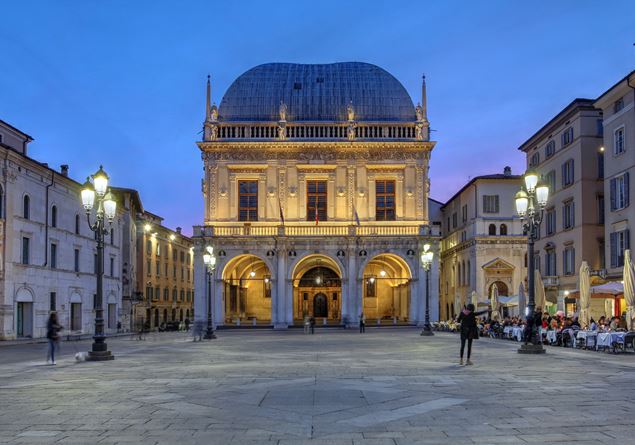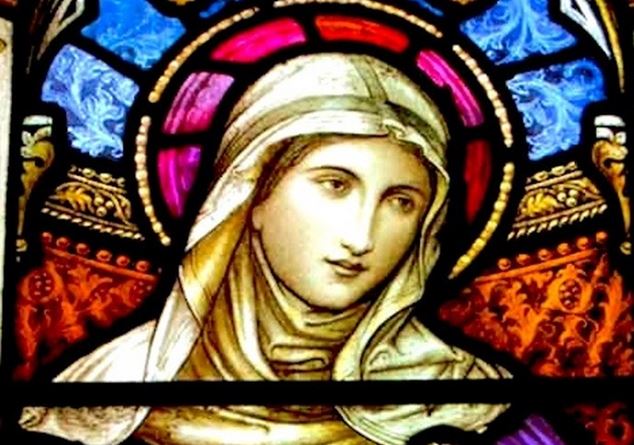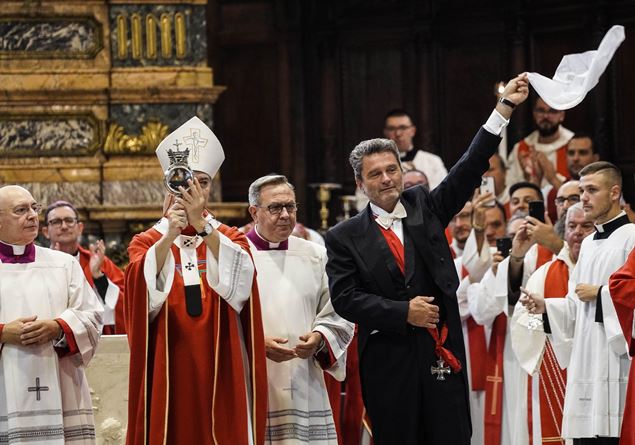On 1 October 1999 John Paul II proclaimed Santa Brigida of Sweden Copatrona of Europe, together with Santa Edith Stein and Santa Caterina da Siena.
Born in 1303 in Finsta in Sweden, when Scandinavia was still Catholic, from parents belonging to the highest nobility and sincerely believers (they confessed every Friday), over ten years he had the first mystical experience when Christ crucified her, arousing in her the vocation for the cloister, but the father imposed them, for political reasons, to marry (she not yet fifteen) the eighteen year old) Gudmarsson.
Eight children, four males and four females were born from the wedding, one of whom will be Santa Caterina of Sweden.
In 1335, Brigida was called to court by King Magnus II as the lady of the white queen of Namur, But this did not prevent her from dedicating herself to the study of mystical literature: He had called the “Master” Matthias to the Castle as a confessor and personal councilor, as well as other theologians and religious who transformed his residence into a center of culture, spiritual life and charity for the poor.
Bride, mother and lady of court
He read the writing, translated in Swedish by Matthias and considered by her “the most precious treasure”, and the works of San Bernardo di Chiaravalle.
Bride, mother, court lady: this was her life for over twenty years, that is, until, in 1244, her husband died, after they had accomplished a pilgrimage to San Giacomo di Compostela.
Along the way, Brigida had been able to realize the dramatic consequences caused by the war of the hundred years between England and France, by the struggle between the emperor and the Pope, while the latter resided in Avignon instead of Rome.
Widowed, he left the castle and was welcomed, thanks to a special concession, As “obsa” in an dependence of the Cistercian abbey of Alvastra and under the direction of the prior, Pietro Olafsson and Maestro Pietro di Skännininx, He built his assets and freedom, even taking off the wedding ring to be the penitent bride of the Crucifix.
Since then, the extraordinary supernatural gifts, the frequent visions and revelations in a state of waking and ecstasy, which prompted her to commit to the Pope’s return to Rome, the restoration of peace between England and France and the reform of society and the Church, multiplied.
The revelations were written by herself, when you awaken from the ecstasy, then dictated to her confessor.
Moved by the Spirit, the Santa planned to found a double monastic order (including men and women) unified, headed by a abbess, who represented Mary on earth, and who should have ruled sixty nuns and supervise the thirteen presbyters, the four deacons and the eight lay brothers of the monastery. This project was never carried out according to the rule you conceived: i fratres and the moniales By order of the Pope they always lived in separate buildings.
Unfortunately, following the Protestant reform, the order was suppressed after in the fifteenth century had spread in almost all northern Europe.
The female branch, still alive and operating, was refounded in the twentieth century by the Blessed Maria Elisabetta Hesselblad with the name of Congregation of the San Salvatore di Santa Brigida.
The denunciation of the Malcostume of the time
On the occasion of the Jubilee organized by the Pope in 1350, the saint went to Rome, where he then settled definitively in a house in Piazza Farnese, who adapted to host the Scandinavian pilgrims who flowed to profit from indulgence, living in total poverty and austerity, mending the bread together with the poor at the entrance of the churches. Witnesses of his kidnappings were the basilicas, the catacombs and the sepulchres of the apostles and martyrs.
His messages denounced the malpractice of the time and contained ads of divine punishments, but also exhortations to penance with the insurance of forgiveness.
Invisa to many, who came to call her “the north witch”, she never let themselves be taken from discouragement. Some Romans one repeating aloud the expression of praise to the Immaculate Conception: “Tota Pulchra es, Maria (all beautiful six, Maria”). She did not break down and continued to pray and as soon as she inton the hymn Ave Maris Stellathe factorous moved away: since then, as thanks to the Virgin, he decided that this hymn was sung daily in his communities.
Which is still done today in brigidine houses of the whole world every day, before the Vespers, accompanying the anthem with the recitation of the Ave Maria.
The missions to the noble courts
In 1364 the saint undertaken a series of pilgrimages to venerate in Assisi S. Francesco, in Ortona a sea the Apostle S. Tommaso, on Mount Gargano the Archangel Michael, in Bari S. Nicola, in Benevento S. Bartolomeo, in Amalfi S. Andrea and Salerno S. Matthew. He also carried out various missions to the court of Queen Giovanna of Naples and at the nobility, but without success.
Returned to Rome, could assist on 10 October 1367 on the return of the Pope Urban V from Avignon; However, a return only temporary return, despite the fact that Brigida, exhorting the pontiff to stay, had predicted that he would die within that year, as in fact happened.
In 1372, together with the children Birger and Carlo, He left pilgrim for the Holy Land and wherever he passed he exercised his prophetic ministry with warnings, messages to the peoples, to the courts and even to the Byzantine emperor.
He traveled praying to the places where Jesus had lived and in turn revised all the moments of the passion in an ecstatic vision, always submitting – as the Lord and the Virgin suggested to him – the revelations to the judgment of his confessor, after his secretaries had translated the text in Latin.
Returning to Rome, he fell sick and died on July 23, 1373.
Her daughter Caterina, who remained a widow in 1351, had always been beside her, in 1374 she brought her mother’s body back home, in the monastery of Vadstenataking on its direction and working, together with other eye texts, to the collection of documents to encourage the canonization of Brigida, which was had on 7 October 1391 by the work of Bonifacio VIII.
Masterpiece of mystical literature
The revelations of the Saint are a literary and mystical masterpiece and make her a prophetex of the new times, Call to a very particular mission and for this reason assisted in a special way by Mary, whom she presents as a central figure in the history of salvation, an accountant next to the Redeemer.
His writings occupy a place of honor in Swedish literature and have exercised a great influence on the spirituality of the late Middle Ages.










